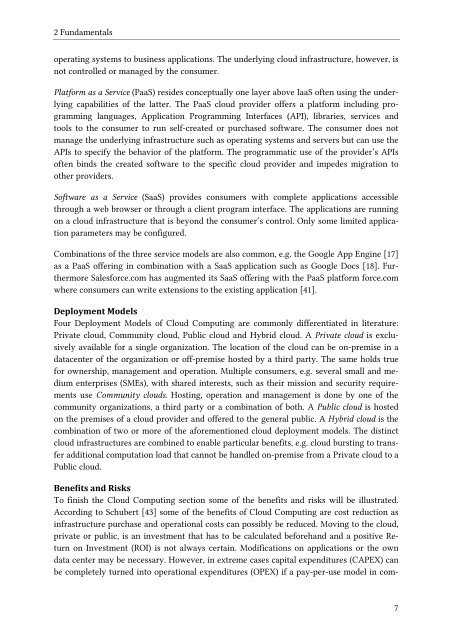Merging of TOSCA Cloud Topology Templates - IAAS
Merging of TOSCA Cloud Topology Templates - IAAS
Merging of TOSCA Cloud Topology Templates - IAAS
You also want an ePaper? Increase the reach of your titles
YUMPU automatically turns print PDFs into web optimized ePapers that Google loves.
2 Fundamentals<br />
operating systems to business applications. The underlying cloud infrastructure, however, is<br />
not controlled or managed by the consumer.<br />
Platform as a Service (PaaS) resides conceptually one layer above IaaS <strong>of</strong>ten using the underlying<br />
capabilities <strong>of</strong> the latter. The PaaS cloud provider <strong>of</strong>fers a platform including programming<br />
languages, Application Programming Interfaces (API), libraries, services and<br />
tools to the consumer to run self-created or purchased s<strong>of</strong>tware. The consumer does not<br />
manage the underlying infrastructure such as operating systems and servers but can use the<br />
APIs to specify the behavior <strong>of</strong> the platform. The programmatic use <strong>of</strong> the provider’s APIs<br />
<strong>of</strong>ten binds the created s<strong>of</strong>tware to the specific cloud provider and impedes migration to<br />
other providers.<br />
S<strong>of</strong>tware as a Service (SaaS) provides consumers with complete applications accessible<br />
through a web browser or through a client program interface. The applications are running<br />
on a cloud infrastructure that is beyond the consumer’s control. Only some limited application<br />
parameters may be configured.<br />
Combinations <strong>of</strong> the three service models are also common, e.g. the Google App Engine [17]<br />
as a PaaS <strong>of</strong>fering in combination with a SaaS application such as Google Docs [18]. Furthermore<br />
Salesforce.com has augmented its SaaS <strong>of</strong>fering with the PaaS platform force.com<br />
where consumers can write extensions to the existing application [41].<br />
Deployment Models<br />
Four Deployment Models <strong>of</strong> <strong>Cloud</strong> Computing are commonly differentiated in literature:<br />
Private cloud, Community cloud, Public cloud and Hybrid cloud. A Private cloud is exclusively<br />
available for a single organization. The location <strong>of</strong> the cloud can be on-premise in a<br />
datacenter <strong>of</strong> the organization or <strong>of</strong>f-premise hosted by a third party. The same holds true<br />
for ownership, management and operation. Multiple consumers, e.g. several small and medium<br />
enterprises (SMEs), with shared interests, such as their mission and security requirements<br />
use Community clouds. Hosting, operation and management is done by one <strong>of</strong> the<br />
community organizations, a third party or a combination <strong>of</strong> both. A Public cloud is hosted<br />
on the premises <strong>of</strong> a cloud provider and <strong>of</strong>fered to the general public. A Hybrid cloud is the<br />
combination <strong>of</strong> two or more <strong>of</strong> the aforementioned cloud deployment models. The distinct<br />
cloud infrastructures are combined to enable particular benefits, e.g. cloud bursting to transfer<br />
additional computation load that cannot be handled on-premise from a Private cloud to a<br />
Public cloud.<br />
Benefits and Risks<br />
To finish the <strong>Cloud</strong> Computing section some <strong>of</strong> the benefits and risks will be illustrated.<br />
According to Schubert [43] some <strong>of</strong> the benefits <strong>of</strong> <strong>Cloud</strong> Computing are cost reduction as<br />
infrastructure purchase and operational costs can possibly be reduced. Moving to the cloud,<br />
private or public, is an investment that has to be calculated beforehand and a positive Return<br />
on Investment (ROI) is not always certain. Modifications on applications or the own<br />
data center may be necessary. However, in extreme cases capital expenditures (CAPEX) can<br />
be completely turned into operational expenditures (OPEX) if a pay-per-use model in com-<br />
7
















